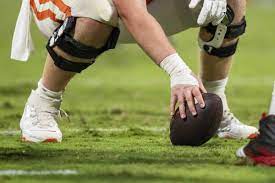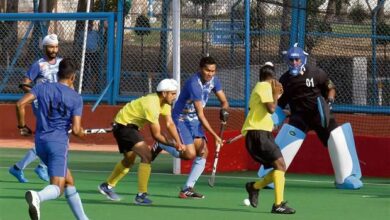Most college football stadiums use artificial turf due to high maintenance costs and unfavorable weather
The choice was made to use an artificial grass playing field when a new football stadium was constructed at South Alabama, which is situated in one of America’s rainiest towns.
Going with a grass field was an easy decision at San Diego State, where the weather tends to be almost ideal almost all the time, but it wasn’t the typical option in major college football.
94 of the 133 colleges that now play in NCAA Division I’s top division have artificial football fields (71%), while 39 have grass (29%), with the majority being Power Five institutions that can afford the care. There were 74 such schools competing on natural grass fifty years ago, and the number really peaked at 75 approximately twenty years ago.
Since then, it has declined despite the fact that Power Five schools are now receiving more funding from billion-dollar TV contracts.
The subject is complex since certain schools—like Arkansas and Mississippi, for instance—have switched surfaces four times in the last century while others, like Michigan and Ohio State, have done it three times.
Even though there are worries about player injuries, many institutions discover that turf is less expensive to maintain, especially for concerts or other non-athletic activities.
A few plays into his debut season with the New York Jets, Aaron Rodgers suffered an injury that sparked requests from NFL players for natural grass fields for their safety (approximately half of the 30 NFL stadiums utilize grass).
The players in major college football are not supported by a union in their efforts to raise issues. Many people do have a preference.
Tanner Mordecai, a quarterback for Wisconsin who has played on turf for the Badgers, at SMU, and on grass for Oklahoma, stated, “I would much rather (play) on grass.” “I’m not familiar with all the studies and other information, but I am aware that it feels better. Simply feels better on the bones and joints. You don’t feel like you are punishing yourself as much.
Certain lower body injuries are more likely to occur while playing football on artificial surfaces, according to certain studies, one of which used NCAA injury monitoring data from 2004 to 2014. However, experts are cautious to come to firm conclusions.
“The preliminary studies have shown that there is an increase in injury risk to the lower extremity on synthetic surfaces vs. grass,” said Bud Cooper, a clinical professor in the University of Georgia’s department of kinesiology. Is it the Bible, then? Not at all.
The majority of Division I’s finest grass fields are located in the South, Southwest, and California, including the brand-new $310 million stadium that San Diego State built approximately a year ago. Climate was a major consideration for selecting grass, according to Derek Grice, a former assistant athletic director at San Diego State. Growing season duration is generally stable.
Plans for Snapdragon Stadium include professional soccer as well as making it a destination for foreign teams and competition. It will also serve as the Aztecs’ home field. That necessitates a grassy field.
Grice has worked at other institutions where choosing the right surface for a space wasn’t always easy. Although ideal circumstances don’t always present, artificial turf’s quality is rising, he said.
“If you look at it, I think the majority of sportsmen will want to play on grass. If the surface is well-maintained,” Grice remarked.
Therein is the problem.
According to Kyle McCord, quarterback for Ohio State, “I think it really depends on the grass.” “I believe that the grass, particularly in the Big Ten region, is rather constant. In general, I believe turf is preferable since you know what you’re going to get with it, however I would argue that excellent grass is preferable to turf.
The practice grounds in Lincoln were converted to grass under the direction of first-year Nebraska head coach Matt Rhule, who has previously coached in the NFL. Artificial grass is present at Memorial Stadium for the Cornhuskers.
“Injuries occur on all surfaces. I’ve never been a fan of something being the be all and end all. But I like grass,” Rhule said. So that we could do more repetitions on the softer surface, “I made the practice fields grass.”
Hancock Whitney Stadium in South Alabama becomes operational in 2020. Because Mobile, Alabama experiences such much rainfall, the school chose FieldTurf, the most popular artificial field among Bowl Subdivision colleges, according to athletic director Joel Erdmann.
“You’re going to need to have a very robust drainage system if you’re going to have a natural grass field, especially in our climate,” he added.
Erdmann believed that the original cost of a grass field would have been comparable and said that the synthetic surface South Alabama utilizes cost roughly $1.6 million.
However, he said, “I believe the problem you get into is the yearly maintenance fees. “You have six grounds people instead of two. Additionally, your $60, $70,000 mower need upkeep.
In the future, the cost of turf vs grass may potentially take legal expenses into account.
Turf fields used for football and other sports might be ripe for litigation, according to Jennifer Steinmetz, an attorney at Tucker Ellis who has represented manufacturers and distributors against product liability claims.
While she acknowledged that institutions may be held liable, she said that she expected grass producers to be the main focus.
The National College Players Association’s executive director, Ramogi Huma, related worries about playing surfaces to brain injuries. The NFL eventually adopted required concussion procedures as a result of pressure from the NFLPA, but college football doesn’t have them since the players don’t have representation.
The playing surface may not matter much to certain players.
Texas defensive back Jahdae Barron recalled his younger years playing on rocks and on the street.
Contributors were AP Sports Writers Eric Olson in Lincoln, Nebraska; Mitch Stacy in Columbus; Jim Vertuno in Austin; and Steve Megargee in Madison.







